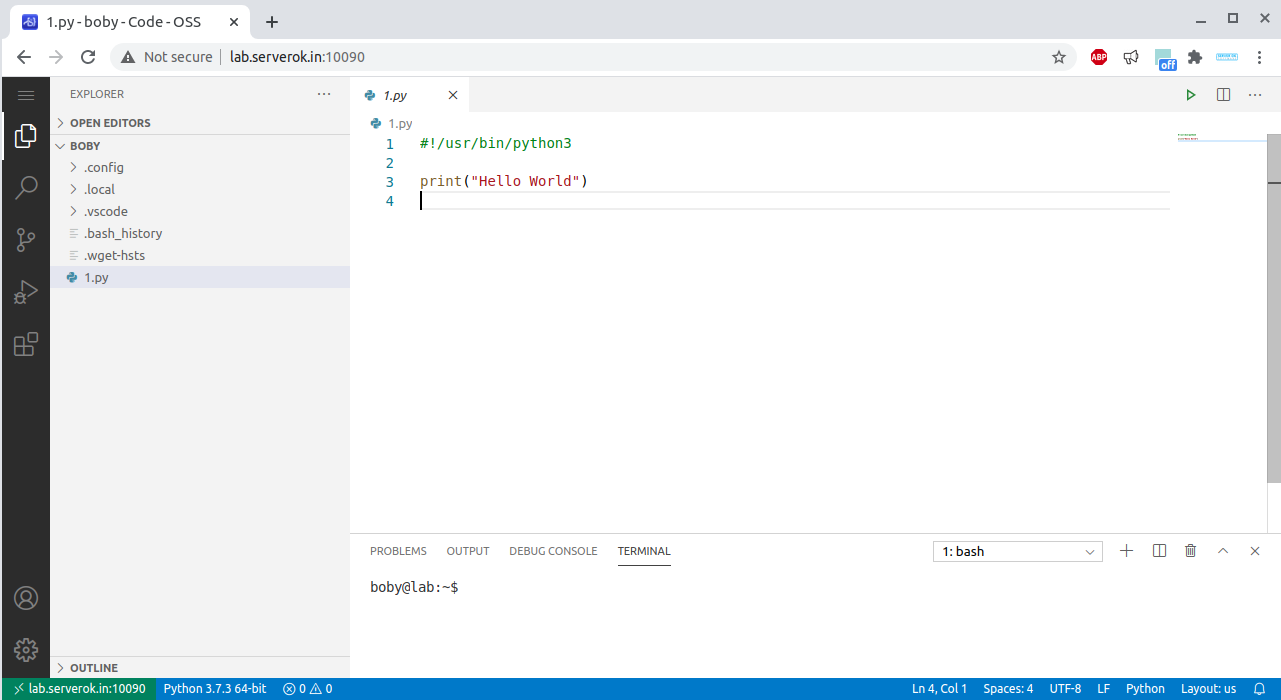To upgrade a ruby gem run
gem update --system VERSION_HERE
Example
gem update --system 1.3.7
See Ruby
To upgrade a ruby gem run
gem update --system VERSION_HERE
Example
gem update --system 1.3.7
See Ruby

Code Server allow you to run Microsoft Visual Studio Code in the browser. Code Server runs on a remote web server, you can access it by going to special url. This allow business to move development environment to cloud, deploy new developer environment on cloud or on premise server quickly with automation tools. Developers can access their secure work environment from any device that have a web browser and internet connection. This is helpful when employees work remotely so all code/files stay on the cloud instead of developers local computer.
https://github.com/cdr/code-server
You can download latest version of Code Server from
https://github.com/cdr/code-server/releases
To install Code Server 3.5.0, run
cd /usr/local/src wget https://github.com/cdr/code-server/releases/download/v3.5.0/code-server-3.5.0-linux-amd64.tar.gz tar xvf code-server-3.5.0-linux-amd64.tar.gz mv code-server-3.5.0-linux-amd64 /usr/local
To start code server, run
/usr/local/code-server-3.5.0-linux-amd64/bin/code-server --bind-addr 0.0.0.0:10090

This will make code server listen to port 10090 on all IP address configured on the server.
You can access the code server at
http://SERVER_IP_HERE:10090
You can find password to login in file ~/.config/code-server/config.yaml

If you don’t want to auto start code server on server boot, you can run the command in tmux or screen.
You can get Free SSL certficate using LetsEncrypt.
Once you got SSL certficate for your domain, you need to do the following. This this example, i use lab.serverok.in domain and user “boby”.
Copy SSL to users directory, so code server can access it.
mkdir -p /home/boby/.config/code-server cp /etc/letsencrypt/live/lab.serverok.in/fullchain.pem /etc/letsencrypt/live/lab.serverok.in/privkey.pem /home/boby/.config/code-server chown -R boby:boby /home/boby/.config
create file
vi /lib/systemd/system/code-server.service
Add
[Unit] Description=code-server [Service] Type=simple ExecStart=/usr/local/code-server-3.5.0-linux-amd64/bin/code-server --bind-addr 0.0.0.0:10090 --cert /home/boby/.config/code-server/fullchain.pem --cert-key /home/boby/.config/code-server/privkey.pem Restart=always User=boby Group=boby WorkingDirectory=/home/boby/ [Install] WantedBy=multi-user.target
To start code server, run a user root
systemctl start code-server
To get Password to login to code server, run
root@lab:~# cat /home/boby/.config/code-server/config.yaml bind-addr: 127.0.0.1:8080 auth: password password: dd39e18a466d89b6579169ae cert: false root@lab:~#
If you want to change password, you can edit the file and restart code server with
systemctl restart code-server
LetsEncrypt SSL expire every 90 days and renew the SSL certificate every month. We will copy over the SSL certficate using a cronjob and restart code server every week.
create file
vi /usr/local/bin/code-server-update-ssl
Add following
#!/bin/bash cp /etc/letsencrypt/live/lab.serverok.in/fullchain.pem /etc/letsencrypt/live/lab.serverok.in/privkey.pem /home/boby/.config/code-server chown boby:boby /home/boby/.config/code-server/fullchain.pem chown boby:boby /home/boby/.config/code-server/privkey.pem systemctl restart code-server
Make it executable
chmod 755 /usr/local/bin/code-server-update-ssl
Create cron job
crontab -e
Add
@weekly /usr/local/bin/code-server-update-ssl > /dev/null 2>&1
APC Cache is an open source opcode caching module for PHP. You can find documentation for APCu at
https://www.php.net/manual/en/book.apcu.php
See PHP

You can use the PHP header() function to do redirect.
To do 301 redirect, use
header('Location: https://new-url/', true, 301);
exit;For 302 redirect, use
header('Location: https://new-url/');
exit;If you need to redirect a site to a new site while keeping the same URL structure, you can use
$newUrl = "https://NEW-URL-HERE" . $_SERVER['REQUEST_URI'];
header("HTTP/1.1 301 Moved Permanently");
Header("Location: $newUrl");
exit;Back to redirect

PECL is a repository for PHP Extensions, providing a directory of all known extensions and hosting facilities for downloading and development of PHP extensions.
https://pecl.php.net/packages.php
To install a PECL extension, run
pecl install pecl_http
To install a specific version, run
pecl install pecl_http-3.2.3
This PHP script will redirect website visitors to HTTPS (SSL) URL. You can add this in your index.php of the website
if (empty($_SERVER['HTTPS']) || $_SERVER['HTTPS'] != "on" ) {
header("HTTP/1.1 301 Moved Permanently");
$newUrl = "https://" . $_SERVER['HTTP_HOST'] . $_SERVER['REQUEST_URI'];
Header("Location: $newUrl");
exit;
}To redirect visitors to a new URL using PHP, use the following PHP code
$newUrl = "https://NEW-URL-HERE" . $_SERVER['REQUEST_URI'];
header("HTTP/1.1 301 Moved Permanently");
Header("Location: $newUrl");
exit;You can also use Apache mod_rewrite .htacess to do the redirection.
gem is package manager for Ruby.
To get list of all install packages, run
gem list
To install a package, run
gem install PACKAGE_NAME
To uninstall a package, run
gem uninstall PACKAGE_NAME
To search for a package, run
gem search PACKAGE_NAME
gem install error libxslt is missing
See Ruby
Create a file 1.go with following content
package main
import "fmt"
func main() {
fmt.Println("My First GoLang Program")
}
To run the program, use command
go run 1.go

To install golang on Ubuntu 18.04, run
apt install golang -y
To execure a system command on a server, use PHP exec function.
For example
<?php
@exec("nslookup yahoo.com 2>&1", $result);
print_r($result);